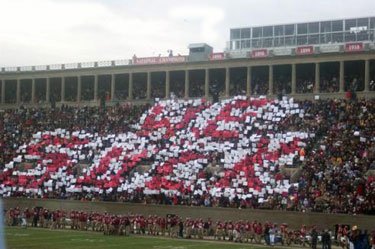
At The Game in 2004, Yalies tricked Harvard fans into holding up signs creating this message.”
Fred Schwarz explains why SAT compression resulted in Harvard becoming an athletic powerhouse.
Harvard has won or shared the Ivy men’s basketball championship every year since 2010–11. And it isn’t just basketball: Harvard football has won or shared five of the last eight Ivy championships, up from a modest one or two per decade over the league’s first half-century (since 1956). In 1977, during oral argument before the Supreme Court on the momentous Bakke affirmative-action case, the distinguished lawyer Archibald Cox found time to joke about how bad Harvard’s football team was. But now the Crimson dominate the league in the only two sports that most people care about. What happened? The explanation lies in … policies imposed in the 1980s and 1990s, which … give Harvard a significant advantage over the rest of the league in recruiting athletes — and provide a lesson in unintended consequences. …
[The key cause was] the College Board’s decision in 1995 to “recenter†its SAT scoring. This meant that instead of the average score for all SAT takers being somewhere around 400, the board arbitrarily set it at 500 (midway between 200 and 800). Cynics suggested that this was done for political reasons, so the discrepancy between white/Asian SAT takers and others would be less dramatic; in any case, the effect was to crunch together all the good students near the very top of the scale. For example, any SAT Verbal score of 730 or higher from before the recentering would be an 800 today. This means that double 800s are “not that great a distinction any moreâ€; over a decade ago, Harvard was already getting 500 double-800 applicants a year, and rejecting half of them. That’s part of the reason for the insane gauntlet today’s high-school students have to run, with activities, music, volunteer work, and all the rest, trying desperately to distinguish themselves from the herd. When applying to elite colleges today, it’s difficult to make yourself stand out from other very smart kids with your test scores or grades, since everyone has high SATs and straight A’s. More important, though, this compression means that the AI standard that Harvard athletes have to meet is not much higher than that of the rest of the league, whereas before the recentering, there was a significant gap, which gave the less selective schools much more latitude. So: Harvard has the best reputation among American universities and the most money to give out for scholarships, and when another member of the league goes after a talented athletic prospect, regulations prohibit it from sweetening the deal by offering extra money or relaxing its admission standards. That’s why the Crimson have been tearing up the league lately, and will probably continue as long as they want to. Letting colleges compete for students is all to the good, and there’s nothing wrong with a group of educational institutions’ agreeing to put education first. But in this case, as so often happens, when strict regulation meets vigorous competition (with a bit of statistical manipulation thrown in), the result is that the rich only get richer.





Please Leave a Comment!